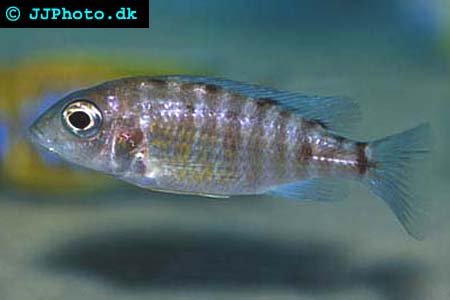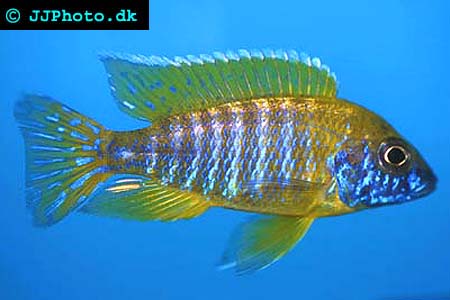Breeding Aulonocara
Most Aulonocara cichlids are remarkably easy to breed in aquariums, but some species will require a little extra attention to get into spawning condition. It is quite common for Aulonocara cichlids to spawn “on their own” without any coaxing from the aquarium keeper (such as temperatures changes, live food feedings or similar). If you want to make an active effort to spawn high quality Aulonocara cichlids, the first step is to choose suitable parent fish. Only healthy and high quality fish with good features should be considered. The parents should of course be without undesirable deformations or other known genetic problems. Make sure the parents are from the same species, unless you want to produce hybrids. Keeping Aulonocara cichlids from different species in the same aquarium will often result in interbreeding.
If you are a beginner, one of the best species to breed is Aulonocara walteri. Provide your Aulonocara walteri cichlids with their own separate aquarium without any other Aulonocara species to avoid hybridisation. It is not recommended to keep just one female and one male Aulonocara walteri together. Instead, one male should ideally be kept with 3-5 females. Keeping several male Aulonocara walteri in the same aquarium will result in a lot of fighting. There are however several cases where the Aulonocara maisoni (Maison's Peacock) have bred when two males have been kept with at least six females. Do not be afraid to experiment, but keep an eye on your Aulonocaras and provide them with plenty of hiding spaces and natural territorial borders to reduce aggression.
Feed the potential parents a nutritious diet and make sure it includes a lot of meaty foods, such as crustaceans, bloodworms or mosquito larvae. Monitor the water quality and keep the pH in the 8.0-8.2 range and the water hardness from 10 to 18 dH. The water temperature should be comparatively high; around 79-84°F (26-29°C) have proven successfully. You need to provide your Aulonocara cichlids with a suitable spawning place in the aquarium, such as a spawning slate or a flat stone.

Aulonocara baenschi female. Copyright www.jjphoto.dk
When your Aulonocara cichlids have gotten into spawning condition, the male Aulonocara will start showing him self off in front of the females. He will also try to make them swim close to the spawning place and check it out. The male Aulonocara can be quite a pest for the females during this period since he will be very persistent and sometimes even violent. To reduce the amount of stress experience by the females you should therefore make sure that they have a lot of places to hide in the aquarium. The females should ideally experience as little stress as possible during the breeding period, since stress can affect the process and make the spawning unsuccessful.
All Aulonocara species are polygamous mouth brooders. They generally produce 25-50 eggs during a spawning. A female Aulonocara will deposit her eggs on the spawning site, and instantly pick them up with her mouth to protect them from harm. The eggs will then be fertilized by a male while they are inside her mouth. Most male Aulonocara cichlids have egg-shaped growths on their bodies to lure the female Aulonocaras close to them. When the female Aulonocara tries to pick the “eggs” from the male, she will instead get a mouthful of semen in her mouth.

Aulonocara baenschi male. Copyright www.jjphoto.dk
You can see that a female Aulonocara is brooding, since her mouth is much larger than usual. Aulonocara cichlids are generally very good holders and will seldom spit out their eggs prematurely. Sever stress can however cause even an Aulonocara to do spit her batch. Many Aulonocara breeders move the brooding female to her own aquarium so that the emerging fry will not be eaten by other fish. Moving a fish is however always stressful for the fish, and can cause a brooding Aulonocara to spit out her offspring. Young females, especially those which have not spawned before, are especially vulnerable. It is therefore recommended to wait until you think the release of the fry is soon to happen, since a premature spitting is not as harmful if the fry is well developed. Moving the brooding Aulonocara to early will also force her to stay away from her group for a long time, and this can cause her to loose her status and be harassed when she return. The Aulonocara will generally brood for four weeks before spiting the fry, but this time can vary between different Aulonocara species.
When there is no yolk sack left for the released fry to feed from, you can begin feeding them small Artemia (Brine Shrimp). Pulverised flake food will also work. If you give the fry a nutritious diet they will grow very fast. When they are around four months old they will start showing their adult colouration, until then all the fry will show the drab female coloration.
Didn't find the info you were looking for? Register for free and ask your question in our Aquarium forum !
Our knowledgeable staff usually responds to any question within 24 hours
Related Articles
Aulonocara - Information about AulonocaraBreeding the Sulphur-Crested Lithobate: Otopharynx lithobates - A detailed article about breeding this Lake Malawi mouthbrooder, together with some useful general tips.
Haplochromis - Information about Haplochromis
Home-made Rocks for the Mbuna Aquarium - A guide to help you mad home made rocks for your Mbuna aquarium.
Keeping Pseudotropheus - Information about Keeping Pseudotropheus
Malawi Cichlids - Information about Malawi Cichlids
Pseudotropheus - Information about Pseudotropheus
Breeding Pseudotropheus - Information about Pseudotropheus Breeding
Pseudotropheus introduction - Basic information about Pseudotropheus cichlids from lake Malawi.
Fish News
Aquarium Forum
Calculators
Free Aquarium Ebook
Feedback
Fish Anatomy
Link to us
Photo gallery
Plant species
Tropical fish species
By Common name
By Scientific name
Tropical Marine fish
By Common name
By Scientific name
Algae Control
Aquarium Decoration
Aquarium Resources
Aquatic Plants
Barb Fish
Betta Fish
Breeding Fish
Catfish
Central American Cichlids
Cichlids
Clownfish
Corals
Corydoras Catfish
Discus Fish
Dwarf Cichlids
Fish Diseases
Frogs and Turtles
Goby Fish
Goldfish
Gourami
Invertebrates
Jellyfish
Killiefish
Lake Victoria Cichlids
Livebearers
Malawi Cichlids
Marine Aquariums
Marine Aquarium Fish
Other Fish
Pleco
Predatory Fish
Photography
Pond Fish
Responsible Fish Keeping
Rainbow Fish
Shark Fish
South American Cichlids
Tanganyika Cichlids
Tetra Fish
Tropical Fish Food
